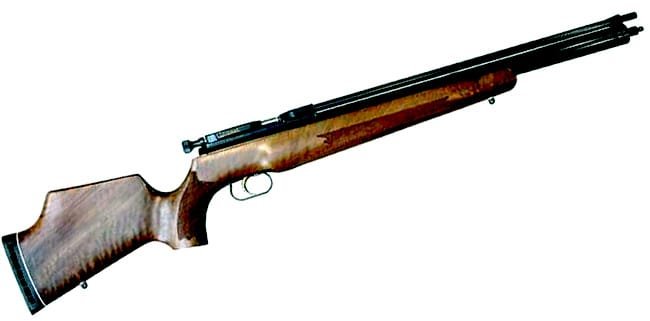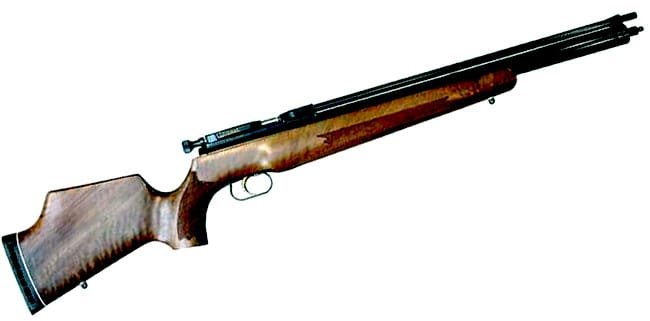Testing an airgun you know nothing about: Part Two


The Shamal from Air Arms is a precharged pneumatic (PCP) rifle that was unknown to me and I had to figure out how to best test it.
This report covers:
- PCPs
- Shamal
- Chronograph
- Daystate Huntsman Mark 2
- Point
- Multi-pump pneumatics
- Finding the max number of pump strokes
- What to expect from a multi-pump
- Single stroke pneumatics
- Summary
Today we look at pneumatics that are unknown to us and discover how to test them. I said in Part 1 that spring-piston airguns are where unknowns happen most often, but don’t overlook pneumatics. They can fool you as well.
PCPs
I’ll start with PCPs that are the oldest type of airguns, yet the modern ones are also the newest—having started in 1980 when Daystate converted a tranquilizer dart launcher into a .22 caliber pellet rifle. It was called the Huntsman and I had one as my first PCP. From it I learned that all PCPs do not operate on a 3,000 psi fill.
Shamal
The Huntsman experience prepared me for the Air Arms Shamal that came along later. Let’s read what I said about it in my report dated May 16, 2014.
“The Shamal wasn’t the first PCP I ever owned — I think it was probably the second. I remember receiving it and discovering to my utter surprise that the rifle shot very slow with a fresh 3,000 psi fill. So, I recorded the velocity of each of the first 66 shots and learned that the rifle didn’t really come up to its power band until somewhere between shots 29 and 38, depending on how tight I wanted the power curve to be.”
“This rifle didn’t come with a manual, so when I got it I had to discover the pressure curve on my own. I did, and it turned out the rifle wanted an initial fill pressure of 2,600 psi”
The shots listed below are within the 66 shots, but I numbered these at the point where the velocity had risen to a reasonable level.
Shot Vel.
1 742
2 740
3 748
4 744
5 745
6 746
7 757
8 754
9 748
10 763
11 774
12 775
13 770
14 771
15 —-
16 772
17 —-
18 782
19 782
20 790
21 780
22 801
23 791
24 804
25 806*
26 793
27 800
28 799
29 801
30 —-
31 —-
32 782
33 788
34 778
35 775
36 775
37 769
*Fastest shot
That’s what I went through while learning the Shamal. Fortunately I knew that other PCP rifles perform well on lower fill pressures, so once I saw the chronograph numbers I was able to make sense of things.
Chronograph
Are you seeing the importance of a chronograph? With the B15 I first had to get the rifle to shoot a pellet, but after it did a chronograph was important for all that followed. With the Shamal I wouldn’t have known anything unless I used one, because every shot sounded the same. This is why you can’t rely on numbers like the fill pressure, alone.
Daystate Huntsman Mark 2
I got a new Daystate Huntsman Mark 2 PCP to shoot field target with. That rifle did come with a manual and also had the maximum working pressure (MWP) engraved into the receiver. The max working air pressure was 2650 psi. It gave 24 solid shots and I could squeeze two more out if the targets were close enough.
Point
The point of this discussion is that you need to establish what air pressure a gun needs to be filled to and it won’t always be what you think. When you know nothing about the PCP it’s best to have a way to test it, and the chronograph is a good way. Never forget the lesson we learned with the USFT that uses 1550 psi to get 50+ powerful shots,
Multi-pump pneumatics
Though multi-pumps are pneumatics they are different than PCPs and there can be surprising things about them, as well. For starters, not all of them can be pumped at all times. Many multi-pumps must first be cocked before they will accept a pump of air. This has become more common today than in the past. There once was a time when Sheridan Supergrades seemed broken because they wouldn’t accept a pump of air without first being cocked.
Another curiosity is the maximum number of pump strokes each multi-pump will tolerate. A Daystate Sportsman Mark II tops out at 5 pump strokes, while a Benjamin model 700 will take as many as 20. Many top out at 8 strokes, but some can take 10. The Yehwa 3B Dynamite requires 150 pumps to be filled all the way!
Finding the max number of pump strokes
If you don’t know the max number of pumps for a particular airgun, a chronograph will once again help. Start with three pumps and chrono the velocity with a pellet. Increase by one pump stroke until the amount of the velocity increase starts to taper off. When each additional pump stroke adds less than 10 f.p.s., stop. You have reached the maximum. Personally I would then back off to a lower maximum number of pumps as maximum for that airgun.
What to expect from a multi-pump
For smallbore multi-pumps the most power I’ve seen a .22-caliber rifle achieve is just over 25 foot-pounds. So, go into testing expecting that or less. From that you can determine the velocity to expect from pellets of a given weight. And there are some simple caveats you can apply.
For example—expect a vintage multi-pump to generate less energy than a modern one of the same caliber. A modern .177 multi-pump may get up to 12 foot-pounds. A vintage one in the same caliber might get only half of that. And these are just rough estimates. The chronograph will give you the precision.
Single stroke pneumatics
I only have a little to say about single strokes. Their power will always be low. Expect 5-10 foot-pounds from rifles in their prime and 3 to 5 for similar pistols.
Single stroke pump cups harden over time. To generate more power, pump them almost all the way five times to warm up the pump cup and then pump all the way to shoot. That will get you a significant velocity increase.
Summary
The pneumatic seems easier to test than the spring-piston airgun, to me. But that may just be my personal experience speaking.
The post Testing an airgun you know nothing about: Part Two first appeared on Pyramyd AIR.



Leave a Reply
You must be logged in to post a comment.